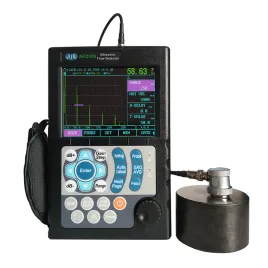Operating Principle of Ultrasonic Flaw Detector
Ultrasonic flaw detectors are indispensable tools in non-destructive testing (NDT) applications, allowing inspectors to detect, locate, and characterize defects, discontinuities, and flaws in materials and structures without causing damage. Understanding the operating principle of ultrasonic flaw detectors is crucial for effective flaw detection and analysis.
1. Ultrasonic Wave Propagation:
The operating principle of ultrasonic flaw detectors is based on the propagation of high-frequency sound waves, known as ultrasonic waves, through materials. When an ultrasonic transducer emits a short burst of ultrasonic waves into a material, these waves travel through the material until they encounter an interface, boundary, or defect.
2. Reflection and Echo Formation:
When an ultrasonic wave encounters a boundary between two materials or a defect within a material, a portion of the wave is reflected back towards the transducer. This reflected wave, known as an echo, carries information about the size, shape, and location of the defect. The time delay between the emission of the ultrasonic pulse and the reception of the echo is used to determine the distance to the reflector.
3. Echo Detection and Analysis:
Ultrasonic flaw detectors are equipped with ultrasonic transducers that emit ultrasonic pulses and receive echoes. The device measures the time-of-flight (TOF) of the ultrasonic waves and calculates the distance to the reflector based on the speed of sound in the material. By analyzing the amplitude, shape, and timing of the echoes, inspectors can identify and characterize defects such as cracks, voids, inclusions, and delaminations.
Additional reading:What tool measures engine speed?
What are the 4 movements of a drone?
Top 5 Must-Have Propeller Stands for Boats
Revolutionizing the Industry: Motor Speed Measurement?Example topic: "Is The Smartphone the Future of Motor Speed Measurement?
Lighter drones: a game changer in photography?
How do I select a 10 kg thrust brushless motor for my application?
What is Hydrostatic Pressure Testing?
4. Pulse-Echo Technique:
The most common technique used in ultrasonic flaw detection is the pulse-echo technique. In this technique, a single transducer is used to both emit ultrasonic pulses and receive echoes. The transducer alternates between transmitting and receiving modes, allowing for continuous inspection of the material. The time between the transmission of the pulse and the reception of the echo is used to calculate the distance to the reflector, while the amplitude and shape of the echo provide information about the nature of the defect.
5. Display and Interpretation:
Ultrasonic flaw detectors typically display ultrasonic waveforms in real-time, showing the amplitude of the echoes as a function of time or distance. Inspectors interpret these waveforms to identify and characterize defects in the material. Advanced ultrasonic flaw detectors may also feature signal processing algorithms, data analysis tools, and imaging capabilities to enhance defect detection and analysis.
Conclusion:
Ultrasonic flaw detectors operate on the principle of ultrasonic wave propagation, reflection, and echo formation. By emitting ultrasonic pulses into materials and analyzing the echoes received from defects, these devices enable inspectors to detect, locate, and characterize flaws without causing damage. Understanding the operating principles of ultrasonic flaw detectors is essential for effective flaw detection and analysis in non-destructive testing applications across industries.
When to Use drone motor thrust?
How do I pass inspection in Texas with a check engine ...
7 Essential Tips for Using a Function Generator
Spectrum Ana vs. Traditional Ana: Which One Wins?
10 Things to Consider When Buying Tape Shear Adhesion Tester
Automatic Capsule and Soft Gel Hardness Tester
When to Use Ball Tack Tester?
Previous: Why Drone Motor & Propeller Test Kit is a Game-Changer for Drone Enthusiasts
Next: None
Related Articles
If you are interested in sending in a Guest Blogger Submission,welcome to write for us!













Comments
0